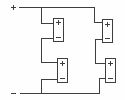General Wiring Diagrams
Matching the speaker load with your amplifier's output impedance is crucial for both optimal performance and amp protection. Here’s why: First, ensuring the correct impedance match allows for the maximum transfer of power from the amplifier to the speakers, delivering the best possible sound quality. Second, using an incorrect impedance load can place unnecessary strain on your amplifier, potentially causing overheating, damage, or even amp failure.
If you’re unsure about the appropriate impedance for your system, it’s always safer to choose a higher impedance speaker. A higher impedance load helps to protect the amplifier by reducing the risk of excessive current flow, ensuring a longer lifespan for your gear.
In multi-speaker systems, the way you wire speakers together (whether in series or parallel) significantly affects the overall impedance. Series wiring increases impedance, while parallel wiring decreases it. Understanding the relationship between speaker wiring, impedance matching, and amplifier output is vital for achieving both safe operation and superior sound quality.
By properly matching the impedance of your speakers with the amplifier, you ensure that your audio system delivers powerful, clear sound while avoiding potential damage to your equipment. Always consider the impedancespecifications when setting up your system for the best possible listening experience and gear longevity.
| Wiring Configuration for 2 Speakers in Parallel | |
 Two 4 ohm speakers = 2 ohm load Two 8 ohm speakers = 4 ohm load Two 16 ohm speakers = 8 ohm load Two 4 ohm speakers = 2 ohm load Two 8 ohm speakers = 4 ohm load Two 16 ohm speakers = 8 ohm load |
|
| Wiring Configuration for 2 Speakers in Series | |
 Two 2 ohm speakers = 4 ohm load Two 4 ohm speakers = 8 ohm load Two 8 ohm speakers = 16 ohm load Two 2 ohm speakers = 4 ohm load Two 4 ohm speakers = 8 ohm load Two 8 ohm speakers = 16 ohm load |
|
| Wiring Configuration for 4 Speakers in Parallel | |
 Four 8 ohm speakers = 2 ohm load Four 16 ohm speakers = 4 ohm load Four 32 ohm speakers = 8 ohm load Four 8 ohm speakers = 2 ohm load Four 16 ohm speakers = 4 ohm load Four 32 ohm speakers = 8 ohm load |
|
| Wiring Configuration for 4 Speakers in Series/Parallel | |
 Four 4 ohm speakers = 4 ohm load Four 8 ohm speakers = 8 ohm load Four 16 ohm speakers = 16 ohm load Four 4 ohm speakers = 4 ohm load Four 8 ohm speakers = 8 ohm load Four 16 ohm speakers = 16 ohm load |

